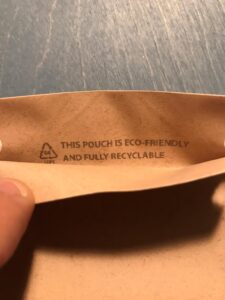I get sad and sometimes even angry when I notice misleading, incorrect or plain fake sustainable packaging. Large corporations are setting a very good tone and example of how to implement environmentally friendly packaging, bet smaller ones often are cheated. I understand that initial driving force should be celebrated, but I see companies using wrong packaging probably because of lack of knowledge and information. And some companies are benefiting by selling fake sustainable packaging. This has to stop. This is my attempt to shed more light on what is sustainable packaging and how to select one that works for you. My experience comes from flexible packaging, so I’ll be mostly concentrating on them as they are one of the most difficult issues to solve.
Things to watch out for
Worst examples in this case are intentionally fake packaging. There are lots of packaging that are marked by TUV Austria or Din Certco Compostable or Bio-Based marking. But each logo must have a serial number underneath it, which can be easily checked that it is real and valid. Simply printing compostability or recyclability signs won’t make it neither compostable or recyclable. As you can see in the photo below, it states that this pouch is eco-friendly and recyclable, has a recyclability code 4, which means that it is made from LDPE plastic. However, it is clearly paper on the outer layer and it has LDPE as the inner layer. This is not in any way eco-friendly or recyclable.

Before diving into specifics of sustainable packaging, first let me briefly explain what different terms actually mean, which are widely used and misused. Take a look at the waste management hierarchy below. Options at the top are more preferred than the lower ones. Reusing the same packaging means, for example, using the same cup for coffee refills in your gas station. Source reduction means that a 5g recyclable flexible packaging is better than 50g rigid plastic container, which is also better than 200g of a glass mug for the same amount of product. Recycling and composting means that we can create the same material from such waste and reuse it. Energy recovery is burning waste in order to generate electricity or heat cities in winter time. Waste goes to landfill when no other options are available and is least preferred.

Let’s get some background information covered
Bio-based indicates that the material is produced from organic and renewable sources, like wood, sugarcane, corn. This term is typically used for paper or bio plastics. However, this does not mean anything about the end life of this material.
Biodegradable means that the material will break down into its base components. However, this does not indicate how long it will take and if the resulting product is safe to use. Biodegradation is just the process of nature breaking down materials into their component parts. Biodegradable things aren’t always strictly “organic” and microplastics can be the result of this process.
Industrially compostable means that the material will break down into safe compost. Industrial conditions mean that the time frame (up to 6 months), temperature (55-70C), humidity, aeration and presence of microorganisms has to be met. In Europe this process is governed by EN 13432 standard. By slightly tweaking this process, it is possible to achieve anaerobic digestion, when methane gas is released in the same process, which is captured and bio-fuel is the byproduct.
Home compostable in essence means the same as industrially compostable, but at much poorer environment conditions, like in your garden compost bin. This is not governed by any European standard as environments in home compost bins vary extremely in different regions. Composting bin in south of Spain acts very differently in a composting bin in north of Finland.
Recyclability codes show what kind of polymer was used to create the material and to what it can be recycled back. Most polymers can be recycled back to its initial stage, problems arise when different plastics are laminated together as different films have very different characteristics. In most cases, only packaging that is made from the same polymer can be recycled.

Important information to take into account for sustainable packaging
When analyzing sustainable packaging and its application I focus on these things:
The source of the material:
Production process:
Barrier properties for food products:
What happens after disposal:
Other less significant points, but worth to consider:
We are here to help
There are a lot of things to consider when doing the right thing with your packaging and I understand this can become overwhelming very fast. When in doubt, consult with a specialist and think about the same steps as listed here. Some companies have limitations in their production capabilities and can downplay the importance of some points and exaggerate the other. It’s always a good idea to validate your plan by more specialists. If you are having trouble finding one, feel free to contact me and we can discuss it.
We understand that you might be new to questions of packaging and sustainability. And it can all get quite confusing quickly. That’s why we are happy to dedicate our time to helping you navigate through it all. Contact us for a free consultation and we’ll help you come up with the best result for your business.
You still have active cart items in this language, if you want to switch to the other language, cart contents will be deleted.
You can only reorder items that were ordered in the same language/currency combination you are currently in.